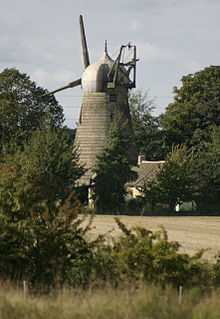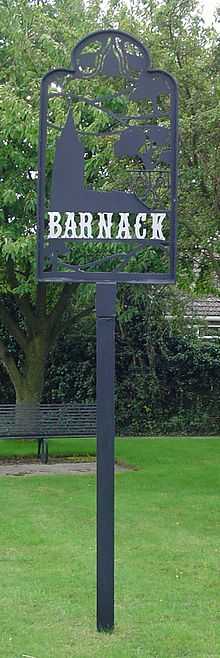Barnack
| Barnack | |
 Anglo-Saxon tower and Early English spire of St John the Baptist's church |
|
 Barnack | |
| Population | 931 [1] |
|---|---|
| OS grid reference | TF0705 |
| Civil parish | Barnack |
| Unitary authority | Peterborough |
| Ceremonial county | Cambridgeshire |
| Region | East |
| Country | England |
| Sovereign state | United Kingdom |
| Post town | Peterborough |
| Postcode district | PE9 |
| Dialling code | 01780 |
| Police | Cambridgeshire |
| Fire | Cambridgeshire |
| Ambulance | East of England |
| EU Parliament | East of England |
| Website | Barnack Parish Council |
| |
Barnack is a village and civil parish, now in the Peterborough unitary authority of the ceremonial county of Cambridgeshire, England.[2] Barnack is in the north-west of the unitary authority, 3.5 miles (5.6 km) south-east of Stamford, Lincolnshire. The parish includes the hamlet of Pilsgate about 1 mile (1.6 km) northwest of Barnack. Both Barnack and Pilsgate are on the B1443 road. The 2011 Census recorded a parish population of 931.[1]
Barnack is historically part of the Soke of Peterborough, which was associated with Northamptonshire but had its own County Council from 1888 until 1974. From 1894 until 1974 there was a Barnack Rural District that was a subdivision of the Soke.
Barnack is notable for its former limestone industry, its Anglo-Saxon parish church and an unusual early Bronze Age burial.
The Barnack burial
The Barnack burial is an important early Bronze Age find. It comes from a complicated monument which was expanded and altered on at least three different occasions. The original burial was very rich for the period, but was covered by only a small barrow. Later additional burials and cremations were cut into the barrow, and it was enlarged twice. Probably at the same time, three concentric ditches were dug around the barrow. The final monument contained at least 23 bodies and had a diameter of 50 metres (160 ft).
When gravel quarrying threatened the barrow in 1974, the decision was taken to excavate. The objects recovered were donated to the British Museum, but replicas are displayed in Peterborough Museum and Art Gallery.
.jpg)
The primary burial
The primary burial was of a man aged between 35–45. He died sometime between 2330 and 2130 BC. He was very robustly built and quite tall for the time: about 5 feet 10 inches (1.78 m). He was suffering from slight arthritis. Marks on his bones, and those of the other people in the barrow, show that they were used to squatting. It is unknown if this was due to their work or just how they sat. His teeth had no disease but were well worn, showing he ate mainly a gritty diet of cereals.
The grave goods
The grave goods of the primary burial are unusual. There is a large "beaker" pot and a copper dagger, common items found in graves of the time. There was a piece of oak charcoal. It is unknown what this was for and no one has been able to make a good guess. There was an unusual pendant made of either bone from a sperm whale or walrus ivory. However, the most unusual item was a stone wrist-guard. These Stone wrist-guards normally have between two and six holes carefully drilled into them. However, the wrist-guard from Barnack has eighteen holes, and each one was filled with a foil-thin disc of gold. The wrist-guard from Barnack was never intended to be worn since the gold caps in the holes would have stopped it from being tied to the arm. Fewer than a hundred such wrist-guards have been found in Great Britain and the example from Barnack is arguably the finest.
Parish church
The Church of England parish church of St John the Baptist is notable for its 11th-century Anglo-Saxon tower.[3] The interior of the church includes a high-quality late Saxon Romanesque sculpture of Christ in Majesty.[4] The tower is topped by what may be one of the earliest spires in England.[3]
Economic and social history

Barnack stone
Oolitic Lincolnshire limestone, including some called "Barnack rag", was a valuable building stone first used by the Romans. Quarrying continued in the Middle Ages when the abbeys at Peterborough, Crowland, Ramsey, Sawtry and Bury St Edmunds all used Barnack stone, and the monasteries frequently were in dispute over the rights to it. Blocks of stone were transported on sleds to the river Welland and loaded onto barges on which they were taken down the River Nene and the Fenland waterways. Most notably, Barnack stone was used to build Peterborough and Ely Cathedrals.[5] Barnack stone was also used extensively for buildings in Stamford.[6]
It is likely that the stone was also carved in the village. A possible Barnack school of Anglo-Saxon sculpture has been identified.[7]
The stone was used for numerous buildings in Barnack itself, most notably the parish church. Another notable example is 7 Station Road, which is a 13th[5] or 14th century house remodelled in the 16th or early 17th century.[8] It is a Grade II* listed building.
The best Barnack stone had been worked out by about 1460, but after the dissolution of the monasteries, supplies became available from demolition of the Fenland monasteries and was re-used in Cambridge colleges.[9][10] Lesser-quality Barnack stone continued to be quarried until the 18th century,[5] and in 1825 it was quarried as roadstone for the Great North Road.[6]
After the useful stone had been removed, the bare heaps of lime-rich rubble were gradually covered by a rich carpet of wild flowers, such as the pasque flower and pyramidal orchid, which can be seen today. The quarry area, now a National Nature Reserve,[11] is called the "Hills and Holes"[5] or "Hills and Hollows".

Mills
Barnack water mill was built in the 18th century.[12] Its undershot water wheel is in situ but none of the mill's interior machinery remains.[12]
Barnack windmill is a tower mill built of Barnack stone in 1797.[13] Its commercial use as a mill ceased in 1914[13] and for a time it stood derelict.[5] Its interior machinery survives complete and the mill was restored in 1959–62.[13]
Railways
In 1846 the Syston and Peterborough Railway opened. It included a station in the parish about 1 mile (1.6 km) north of Barnack. It was nearer Uffington, Lincolnshire than Barnack, so initially it was called Uffington station. The Syston – Peterborough line was absorbed by the Midland Railway, which in 1858 renamed the station Uffington and Barnack. British Railways closed the station in 1952, and that line's nearest station to Barnack is now Stamford. The disused Uffington and Barnack station survives and is a listed building.[14]
In 1867 the Great Northern Railway opened a branch line linking Stamford and Wansford, with a Barnack railway station on the east side of the village. The London and North Eastern Railway absorbed the GNR in 1923 and closed the branch line in 1929.
School and village hall
In the middle of the 19th century a house in the village built in 1797 was converted into the parish school.[15] In the 20th century the school moved to new premises and the building was converted into the village hall.[15]
Notable people
Charles Kingsley, author of The Water Babies, spent his childhood at the Rectory. His brother Henry Kingsley was born there in 1830.[16] They were the sons of the Rev. Charles Kingsley the elder and Mary, née Lucas. The Rectory was largely rebuilt later in the 19th century and is now called Kingsley House.
Nigel Sixsmith, Keytar player and founder member of The Art of Sound, has lived in Barnack.
The artist Wilfrid Wood (1888–1976) lived in a 17th-century thatched cottage, Littlefield on Station Road, Barnack from 1938. The village hall is now named after him.[15]

Amenities
Barnack has one public house, the Millstone Inn, which is controlled by Everards Brewery.[17] There is a primary school, village shop and post office, two bed and breakfasts, an MOT test centre and garage. There are also several other small businesses and an agricultural goods supplier.
References
- ↑ 1.0 1.1 "Area: Barnack (Parish) Key Figures for 2011 Census: Key Statistics". Neighbourhood Statistics. Office of National Statistics. Retrieved 4 September 2013.
- ↑ "Barnack ward". Peterborough City Council.
- ↑ 3.0 3.1 Pevsner 1968, p. 208.
- ↑ Pevsner 1968, p. 209.
- ↑ 5.0 5.1 5.2 5.3 5.4 Pevsner 1968, p. 210.
- ↑ 6.0 6.1 RCHM 1977, pp. 64–69.
- ↑ Cramp 1977, pp. 191–233.
- ↑ "7, Station Road". National Heritage List for England. English Heritage. 19 March 1962. Retrieved 4 September 2013.
- ↑ Woodcock, Nigel; Norman, David (20 August 2010). "Building Stones of Cambridge: A walking tour around the historic city centre". University of Cambridge Department of Earth Sciences.
- ↑ Alexander 1995, p. 116.
- ↑ "Barnack Hills & Holes NNR". Natural England.
- ↑ 12.0 12.1 "Barnack Water Mill". National Heritage List for England. English Heritage. 24 February 1982. Retrieved 4 September 2013.
- ↑ 13.0 13.1 13.2 "National Heritage List for England". Barnack Windmill. English Heritage. 19 March 1962. Retrieved 4 September 2013.
- ↑ "Former station and crossing keeper's house". National Heritage List for England. English Heritage. 24 February 1982. Retrieved 4 September 2013.
- ↑ 15.0 15.1 15.2 "Wilfrid Wood Hall". National Heritage List for England. English Heritage. 24 February 1982. Retrieved 4 September 2013.
- ↑ "Kingsley House". Peterborough Hidden Heritage. Retrieved 19 December 2009.
- ↑ "Millstone Inn". Our Pubs. Everards Brewery. Retrieved 4 September 2013.
Sources and further reading
- Alexander, Jennifer S (1995). "Building Stone from the East Midlands Quarries: Sources, Transportation and Usage" (pdf). Medieval Archaeology 39: 107–135.
- Cramp, Rosemary J (1977). "Schools of Mercian sculpture". In Dornier, Ann. Mercian Studies. Leicester: Leicester University Press. pp. 191–233. ISBN 0718511484.
- Pevsner, Nikolaus (1968). Bedfordshire and the County of Huntingdon and Peterborough. The Buildings of England. Harmondsworth: Penguin Books. ISBN 0-14-0710-34-5.
- "Building Materials and Construction: Stone". An Inventory of Historical Monuments in the Town of Stamford. RCHM. 1977. pp. 64–69.
External links
| Wikimedia Commons has media related to Barnack. |
- Barnack in the Domesday Book
| |||||||||||||||||